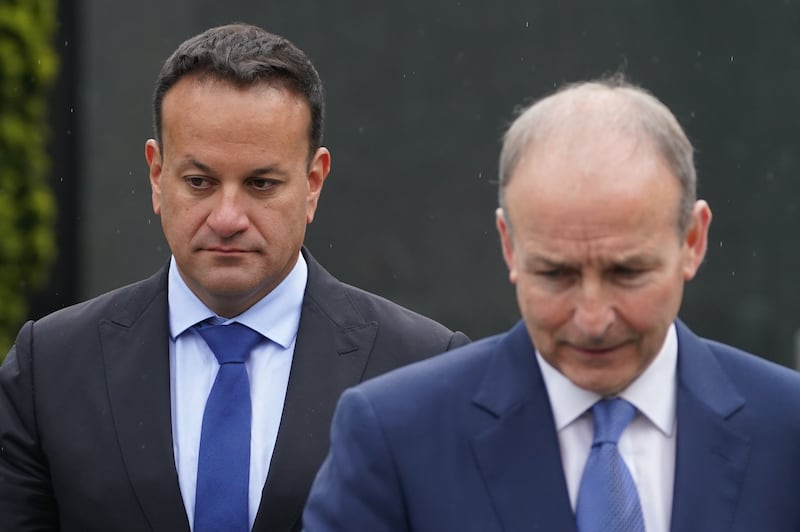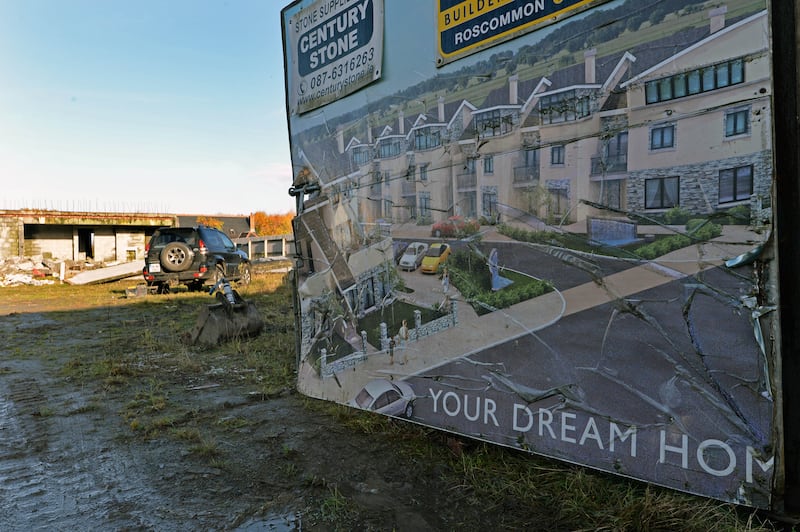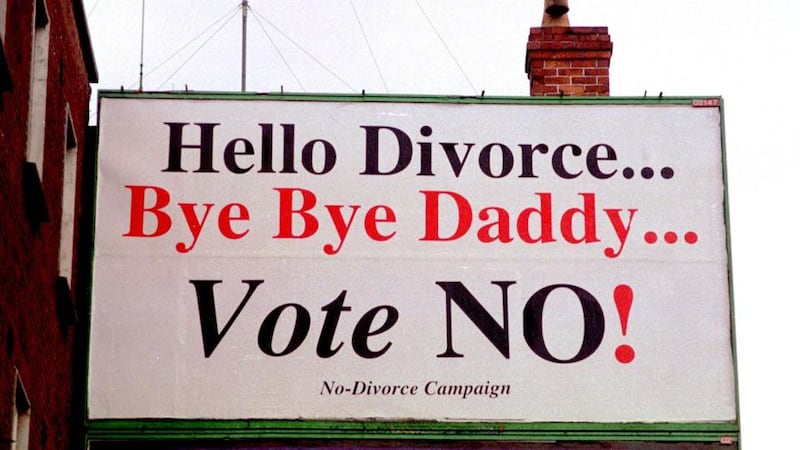“We are where we are”, politicians are fond of saying, as if the present is wholly disconnected from the past. The dizzying pace of change in recent decades has made it harder and harder to understand how we got here, and to remember where we started. Increasingly breathless news coverage and the toxic influence of social media turn the passage of time into a blur. The last three series of Reeling in the Years would leave someone from the 1990s in shock.
Historians, those tasked with explaining change, too often shy away from the recent past, worrying that without the benefit of time (and hindsight), it is too close to see properly. But Diarmaid Ferriter argues that, whatever the risks, historical perspective is exactly what we need. His hugely valuable new follow-up to 2004′s The Transformation of Ireland is “an attempt to make sense of the scale and texture” of a rollercoaster quarter century “through a long historical lens”. What emerges is not just a country radically transformed for the better, but one whose deepest secrets have been exposed.
It has been, Terence Brown wrote in 2004, “an era of revelations and remembering”. Ferriter’s title refers to the tidal wave of scandals that have washed over recent decades, the names of their respective reports now triggers in our minds: Ryan, Murphy, Moriarty, Mahon. From corruption to child abuse, healthcare to policing, “the dark hinterland of the State” has been repeatedly exposed. The “obsessive concern with secrecy and the avoidance of scandal” that characterised the cover-ups of child abuse “could just as easily”, Ferriter writes, “sum up attitudes to a host of long-standing Irish problems”. The more things change, the more they change how we see what came before.

“The old life fails”, the tombstone of Patrick McGill declares, “but the new life comes”. From the Donegal summer school named in McGill’s honour to the shifting corridors of power in Dublin, Ferriter finds a political culture trapped in a cycle of zombie rebirths. The Civil War Coalition of today would have seemed unthinkable in the 1990s, but for a country that has undergone a cultural revolution and multiple economic earthquakes, politics has a striking “frozen in time quality”. Fine Gael continues to suffer “a crisis of identity that was never fully resolved, while Fianna Fáil has survived multiple premature death notices. Meanwhile the risen Sinn Féin has become, as Miriam Lord put it in 2014, “screamingly mainstream”.
READ MORE
Ironically, while young people have rightly lamented that economic and cultural change in Northern Ireland has been less rapid, political change there has been more seismic. For all the recent stasis at Stormont, it is a world way from the late 1990s when dozens were murdered on the streets of Omagh, and the fledgling Belfast Agreement seemed unlikely to survive. Yet the “spoils of peace” have often disappointed, and the tangled web of post-Brexit politics make the late Lyra McKee’s words even more resonant: “I don’t want a united Ireland or a stronger union; I just want a better life”.
A better life has certainly come to most people in independent Ireland. The Celtic Tiger brought greed and excess, and its thoughtlessness left the country “besieged by the forces of the new banal”, but it also brought economic growth in fast forward. Generations of mass emigration ended, jobs were plentiful and the country was awash with money. Booming Ireland could offer the world Viagra, iMacs and financial services, while “strong fundamentals” pointed to a sustainable prosperous future. “If the men and women of Ireland’s past could choose a time to live in,” president Mary McAleese told a US audience in 2003, “there would be a long queue for this one”.
Unfortunately, on top of the strong foundations sat an absurd bubble, fuelled and enabled by those supposed to be responsible. While politicians of all hues shamelessly tried to deflect responsibility (stop “cribbing and moaning”; “we all partied”; “pull on the green jersey”), the inevitable crash felt like a reckoning for a country whose “notions” had gone too far. The details of political corruption and irresponsibility, and of corporate and financial greed, were sordid and pathetic. “Was it for this?”, this newspaper famously asked as the troika arrived to suspend our economic sovereignty.
Ferriter’s impressionistic literary style – more than 100 sentences begin “There was a ...” – is reminiscent of Annie Ernaux’s epic The Years, and is highly effective at capturing the mentality and feel of a time. The breadth of his reading is extraordinary, and his choice of quotations – from newspapers, reports, speeches, novels, poems – is masterful. Yet the non-chronological structure means that concurrent events are sometimes disconnected, and it is certainly less well suited to the structures of the economy. It is difficult to reconcile the debates of the 2010s with policymakers’ later acceptance that the level of austerity, especially on infrastructure investment, was a colossal mistake.

The thematic approach, however, does allow Ferriter to step back and argue that even as Ireland has changed, its biggest problems remain “deep-rooted and historical”, most notably on housing and healthcare. The bubble saw a myopic transformation of Ireland into a sprawling, low-density suburban country increasingly reliant on the car. After the crash, ‘ghost estates” became the scars of “national shame”, and once the economy began to recover, hundreds of thousands of young people could find nowhere to live. Ferriter describes hapless government assertions that addressing the housing crisis would not be “a question of money, resources or ideology” as “nonsense”. The entire “sorry cocktail”, he writes, “marked a great failure of the social contract”.
That contract, Ferriter argues, has always been weaker than we pretend, with aspiration rather than implementation dominating “too many vital issues”. “When historians look back on Ireland’s richest ever decade”, healthcare expert Dr Sara Burke wrote in 2009, “it will seem unfathomable” that so little progress was made on healthcare. Reform has remained “tortuous”, and Ferriter rightly argues that this represents an “egregious failure”, with “too many tragedies to choose from to illustrate the wider failures”. “The weight of history”, he writes, obviously does not always “weigh heavily enough” to provoke radical change.

That weight has been heaviest in society’s relationship with the Catholic Church. In 1995, almost every constituency outside of Dublin followed the church’s advice and voted against the legalisation of divorce. But respect for the clergy would collapse in the revelation of endemic child abuse and systemic cover-ups. As the country reeled from financial apocalypse, 2009′s Ryan and Murphy reports came like thunderclaps. On live television, former Fianna Fáil councillor Michael O’Brien emotionally told a government minister how priests would “rape me ... and bate the shite out of me”, and how the State’s “mealy-mouthed” attitude tore “shreds” from survivors’ bodies.
Ferriter wisely notes that the cultural change that led to the overwhelming votes for equal marriage and abortion rights were about much more than a rejection of the church, not least a renewed vibrancy in youth activism and women’s movements. The seemingly endless revelations of how Ireland has oppressed and abused women – and the relentless courage of those who have created a new reality – demanded new stories and histories to break the silence. We must, Eavan Boland wrote in her final collection, “stop words healing what should not be healed”.
Questions over what Boland called “memory becoming history” have moved centre-stage, from the anniversaries of 1798 and the Famine to the Decade of Centenaries. Ferriter asks if “excessive commemoration or public memory” reflected some “deeper insecurity”, and certainly Ireland has been working out what and who it is. At times that has degenerated into the banality of branding, from “Ireland, inc” to “the best small country in the world to do business” to “Global Ireland”. Yet such boasts, and the promises of a “new politics”, have “remained hollow”. Too often the branding has come before the reality.
Crash would give way to “comeback”, and the huge windfalls of multinational money from Big Pharma and Big Tech would fuel the “Celtic Phoenix”. Ferriter ends before Covid, and it would have been interesting to read more concluding thoughts, but this is a hugely ambitious and valuable first foray into the history of our own times that emphasises how much more there is to be written.
Revelation has, in some ways, led to rebirth, even if we are still often grappling with “national atonement” and how to “make amends”. “For those growing up after the crash and the recovery”, Ferriter notes, “the issue was the unattainability of what had been the norm for the previous generation”. Yet it is impossible to understate how Ireland has become a more prosperous, more tolerant, more open country. Mass emigration has given way to large-scale immigration, creating a diverse country where people want to live, not leave. But even that has unleashed darker sides we had long kept hidden.
Ferriter writes that “the book’s title was prompted not only by what has been revealed about the past, but also how Ireland from the mid 1990s has revealed its potential and its limitations”. Despite all this society’s success, huge numbers of people still have few options for something as fundamental as a home, while our infrastructure and healthcare still lag far behind our wealth. For all the extraordinary change, we still fix a boundary to our progress as a nation; we will go so far, but no further.
Christopher Kissane is a historian, and the host of Ireland’s Edge.
Further Reading
We Don’t Know Ourselves: A Personal History of Ireland since 1958 By Fintan O’Toole
O’Toole has been at the heart of cultural and political debate in Ireland for decades, and his ‘personal history’ conveys the seismic changes he has seen and lived. Read our review here.
The Best Catholics in the World: The Irish, the Church and the End of a Special Relationship (Penguin, 2021) By Derek Scally
Scally explores the country’s emotional, cultural, and political breakup with the Church. Read our review here.
Solar Bones (Tramp Press, 2016) By Mike McCormack
McCormack’s single sentence masterpiece tells the history of a Connacht man’s life viewed backwards from post-Celtic Tiger Ireland. Read our review here.














